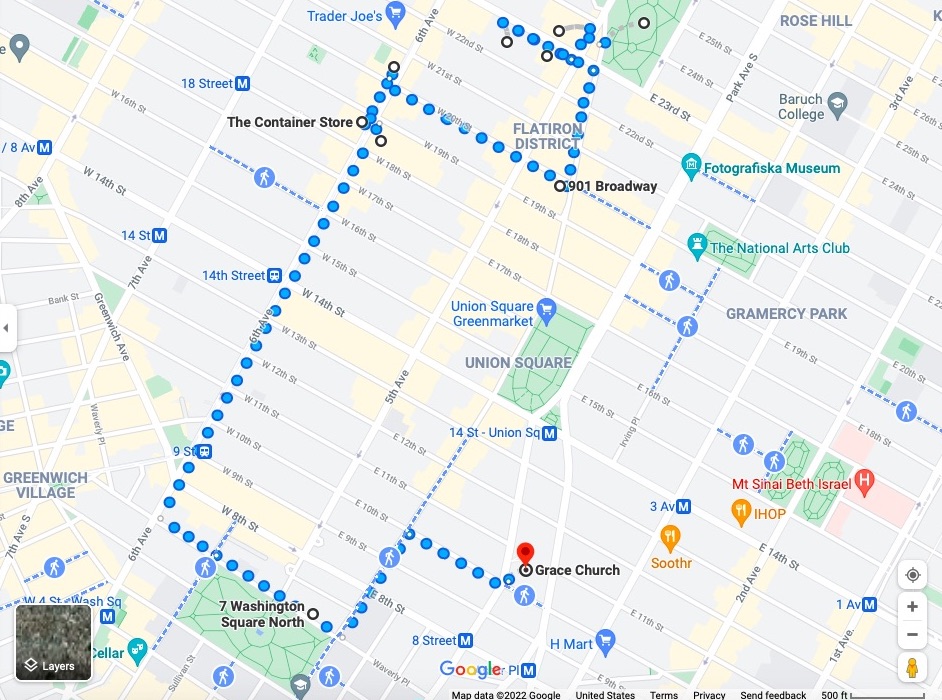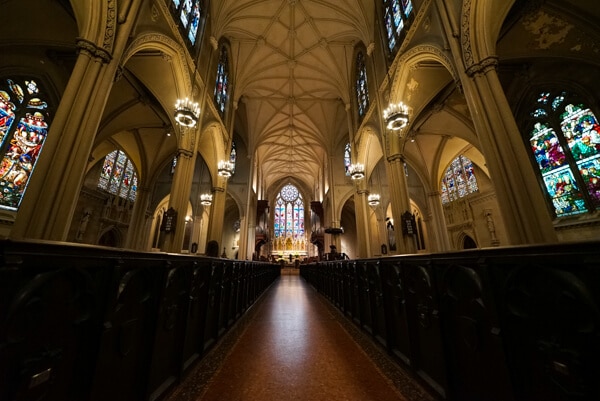
Wharton found great success writing about the insular lives of the extremely rich. But she also delved into a darker side in her collection of ghost stories. As in her novels, the characters in her ghost stories comment on the restrictive, ordered lives of Victorian women. But the added spectral presences, whether seen or merely felt via a chilling breath on a character’s neck, add a menacing layer to her fiction.
See stories inspired by Wharton and others in the delightful production of Dark Ladies at The Players Theatre in Greenwich Village. The play presents three stories whose titles alone send chills up the spine: Drowning in Love, Dead Ringer, and Will Death Do Us Part? Short “palette-cleansing ditties” in the form of music, dance, and poetry are interspersed between the macabre tales. Works are inspired by Wharton, Emily Brontë, and other 19th and 20th century women writers.
A narrator played by Brenda Bell, who is also the director and playwright, guides the audience on this 90-minute journey through the dark side of Victorian female life. Live music from Michael Sgouros accompanies the show.
[Updated June 23, 2024] I’ve always been captivated by the era of the Gilded Age in New York City, which probably explains why one of my favorite weddings in literary history comes from The Age of Innocence by Edith Wharton.
The wedding takes place at Grace Church in New York City. The event unites the wealthy but dissatisfied Newland Archer with May Welland, a radiant, rich, thoroughly vapid society darling. As Archer awaits his bride at the altar, readers are in on a secret: Archer is in love–only not with his bride-to-be.
He’s fallen for May’s cousin Ellen Olenska, who has recently returned from Europe after a mysterious scandal involving her husband, a Polish Count. And while Ellen returns Archer’s feelings, neither of them can afford the disgrace that would result in their being together. They are products of a conservative, rule-bound society and Archer doesn’t have a choice but to marry May.
As he scans the fashionable audience from the lily-adorned altar, Archer sinks into resigned dismay, “recognizing all the same faces in the same boxes…” just like any opening night at the Opera. He sees his wedding, one of many social events of the idle rich, as a foreshadowing of the endless stream of predictable days that stretch out ahead of him.
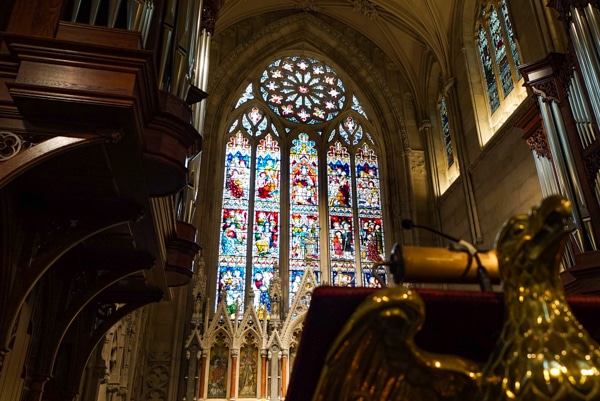
I first read The Age of Innocence in college, long before I moved to New York City but well into my obsession with its hectic crowds and chaotic energy. Edith Wharton’s Gilded Age novel introduced me to an entirely different perspective of the city, a New York that was much smaller and more insulated, with characters who had more money than they knew how to spend. Their lives were dictated by strict social rules and they were under constant scrutiny from each other.
After I moved to New York, I read more of Wharton’s works, this time understanding a little better that they were often based on her real life. The more I read, the more curious I became about Edith Wharton’s New York City.
The year 2020 marked the 100th anniversary of The Age of Innocence, the novel that would earn Wharton the Pulitzer Prize, making her the first woman in history to win the coveted award.
In honor of this milestone, I set out to learn whether Edith Wharton’s New York still existed a century later. I wanted to see signs of her, whether they were from her own life or from the lives of her fictional characters.
In order to do this, I booked a couple of tours with The Bowery Boys and also did some exploring on my own.
What is the Gilded Age?
The Gilded Age in the United States refers to the period from roughly 1870-1900. This was an era that began shortly after the end of the Civil War, when America’s infrastructure was progressing at breakneck speed.
A number of white American men amassed gross amounts of wealth through real estate deals, railroad investments, and stocks and bonds. Many reaped the benefits of the political corruption that was rampant in those days.
The term was coined by Mark Twain, who wrote The Gilded Age: A Tale of Today, an 1873 novel that satirizes the excessive materialism of that time period. The Gilded Age was an era of extreme decadence but also shocking poverty. In New York City, the rich built flashy mansions along Fifth Avenue while at the same time, the poor, minorities, and immigrants in New York lived in squalid tenements and earned menial wages under difficult, dangerous conditions.
The Gilded Age was an era when women couldn’t vote yet, though the women’s suffrage movement was underway. Women from wealthy families were expected to marry young and marry well, always keeping her family’s wealth and social standing in mind.
Edith Wharton (1862-1937) was born in New York City into one of those excessively rich families and like Twain, she criticized the greedy, money-hoarding time period through her novels and short stories. She also made light of the conservative culture and strict social etiquette rules that the rich had to follow.
Edith spent many years of her life in Europe but her writing proves New York was a great influence on her. Let’s take a walk in her shoes, whether real or fictional.
Edith Wharton’s Childhood Home
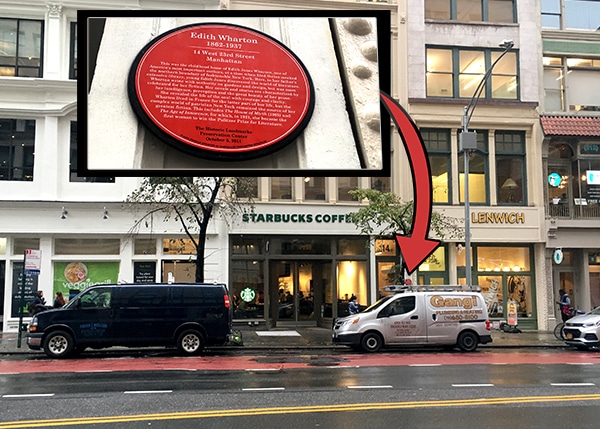
During my first Bowery Boys tour, titled “Edith Wharton’s New York,” our tour guide Carl Raymond (an Edith Wharton expert) said that Wharton set The Age of Innocence in 1870 for a deliberate reason. Born in 1862, the author believed society had changed immensely by the time she reached adulthood.
“The moral order she had grown up with was gone,” Raymond said. Through her novel, she was searching for “that same sense of order, beauty, and grace,” that she developed–not in New York, but in Europe, where she spent many of her formative years.
When her family eventually did return to the U.S., it was rarely for long. In the same fashion as her wealthy fictional characters, Edith’s family only spent winters in New York and retreated to their estate in Newport, Rhode Island every summer.
As Raymond talked about Edith’s life, we were standing across the street from a Starbucks in Manhattan’s Flatiron District. A red plaque just outside the Starbucks entrance marks the building as Edith’s childhood home. This very spot is where Edith spent some of her early years, and also where she happened to develop her passion for books.
The family returned from Europe when Edith was ten years old, an age when she was able to appreciate what she called in her autobiography “the kingdom of my father’s library.” This library was located, as our guide pointed out, at about the same place where Starbucks customers now add cream and sugar to their coffees.
After the tour ended, I circled back to Edith’s Starbucks, feeling a small thrill at sipping coffee in the same space where Edith sat on a “thick Turkey rug…dragging out book after book in a secret ecstasy of communion.”
- Address: 14 West 23rd St. New York, NY
- Subway: N, R, or W to 23rd St.
Eataly, Formerly the Fifth Avenue Hotel
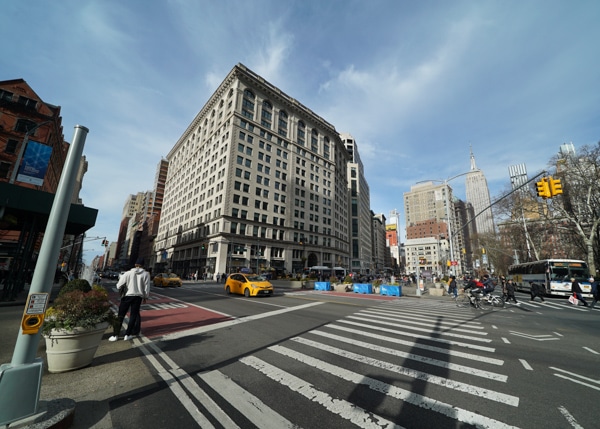
Across the street from her childhood home, Edith would have seen the Fifth Avenue Hotel, a posh six-story white marble Italianate building that was a gathering place for New York’s wealthiest and most powerful.
Edith, who was born Edith Newbold Jones, was no stranger to this moneyed crowd. In fact, the term “keeping up with the Joneses” is said to stem from her family’s great wealth and the competition in fashionable society to own the biggest, most extravagant mansion.
In her novella, New Year’s Day, Edith describes the judgmental attitude and stifling lack of privacy that she and her fictional characters faced in this society.
The story opens on the first day of an unspecified year in the 1870s. A 12-year-old boy is visiting his grandmother in a house across the street from the fancy hotel. Visitors drop in and out of the grandmother’s house all day long, bringing greetings for the New Year. When a servant alerts the group to a fire at the Fifth Avenue Hotel, they move from the dining room table and gather excitedly in front of a large plate-glass window to watch the Fire Brigade and gossip about the hotel guests “staggering out through the smoke in gala array.”
As the wealthy and powerful pour out of the smoldering hotel, the grandmother and her guests hold a running commentary on the socialites rushing out into the street, displaying such scandalous behavior as wearing “short sleeves in broad daylight.”
When, finally and unexpectedly, Lizzie Hazeldean, a married lady of their own social set, runs out of the hotel, not with her husband but with a gregarious bachelor known to all, the spectators are shocked into silence and the wheels are set in motion to ruin Lizzie’s reputation.
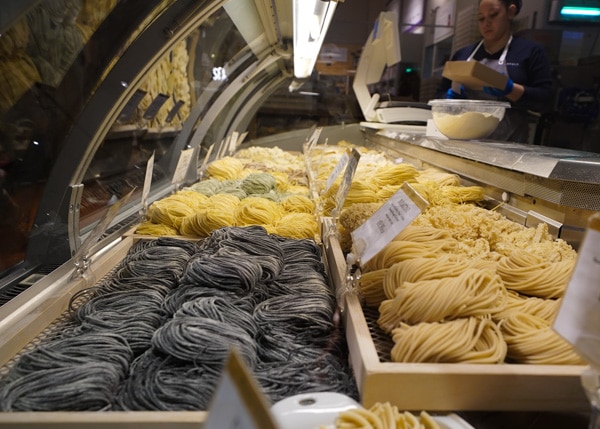
That fishbowl society is long-gone, as is the Fifth Avenue Hotel, which was demolished and eventually replaced with a 14-story luxury office building. Now it houses Eataly, a popular Italian marketplace filled with high-end restaurants and imported groceries.
I wonder what Edith would think of the Italian-goods megastore, with its tourists crowding the aisles smelling of pungent cheese and ground espresso. In her autobiography, A Backward Glance, she does rave about the beauty of Rome, describing in great detail her childhood impressions of its plazas and ruins, its vivid colors and smells, and how easily she learned Italian.
Maybe she would have loved the ease of popping in to Eataly for a cannoli or a glass of wine, or a jar of imported olive oil. More likely though, it would not have lived up to her standards of beauty and grace that she so loved in Italy.
- Address: 200 Fifth Ave., New York, NY
- Hours: Market open daily 9 a.m. – 10 p.m. Restaurant hours vary.
- Subway: N, Q, or W to 23rd St.
Madison Square Park
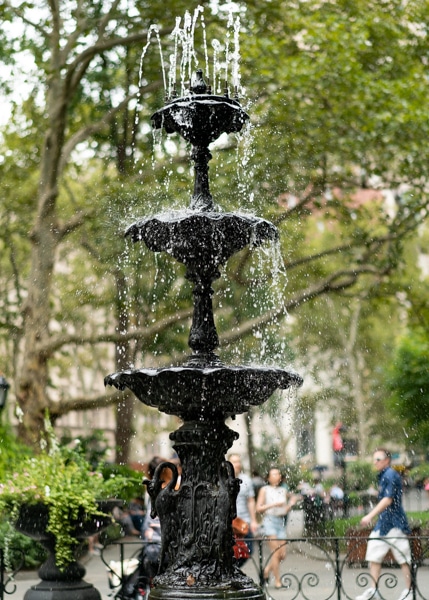
When she wasn’t in Europe or Newport, Edith’s nearest green space in New York City would have been Madison Square Park, a compact, urban park that opened in 1847. With sidewalks that border a small but attractive patch of grass , it would have been the perfect place for a Sunday afternoon stroll.
Today, the past collides with the present: the park is a magnet for lunching New Yorkers, dog-walkers, and tourists. A statue of William Henry Seward, dedicated in 1876, sits a few steps away from the city’s flagship Shake Shack, while some of the city’s most iconic buildings surround the perimeter.
Fun Fact: The arm and torch of the Statue of Liberty sat on display in Madison Square Park from 1876-1882. People could pay 50 cents and climb up to the torch. The proceeds went toward the construction of a foundation that had to be custom-built for the full statue to rest on permanently.
- Madison Square Park Address: 11 Madison Ave., New York, NY
- Subway: N, R, or W to 23rd St.
Ladies’ Mile Historic District
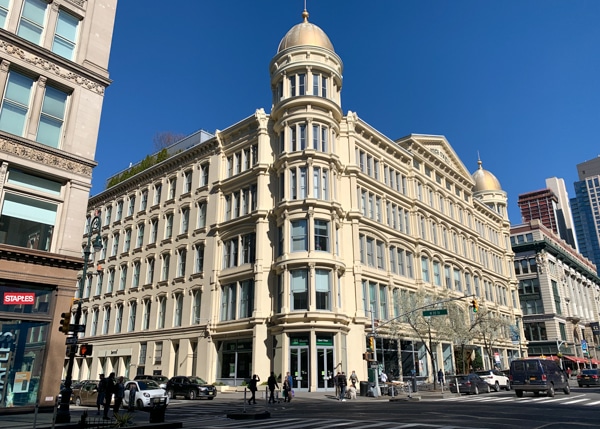
Just next door to Edith’s former childhood home is a Home Depot. It appears, at first glance, to be just another big box store. However, like many of New York City’s buildings, it had a previous life. Just look up, and at the top of the arch above the entrance, you’ll see a lion’s head carved into the façade along with the initials, SB.
Stern Brothers, which moved into this six-story Renaissance Revival building in 1878, was one of the most elegant department stores in the city and though I’ve never seen it mentioned in any of Edith’s books, it seems certain she would have shopped here during any time she spent in New York.
I learned about Stern Brothers on another Bowery Boys tour called Ladies’ Mile and Cast Iron Architecture. Ladies’ Mile was the shopping district for nineteenth century socialites. The district took up 28 city blocks and was located between 15th and 24th Streets, from Sixth Avenue to Park Avenue South.
Our tour met at Union Square and headed west on 16th Street, while our tour guide Emma Guest-Consales, pointed out the elaborate architecture that I had never before paid such close attention to.
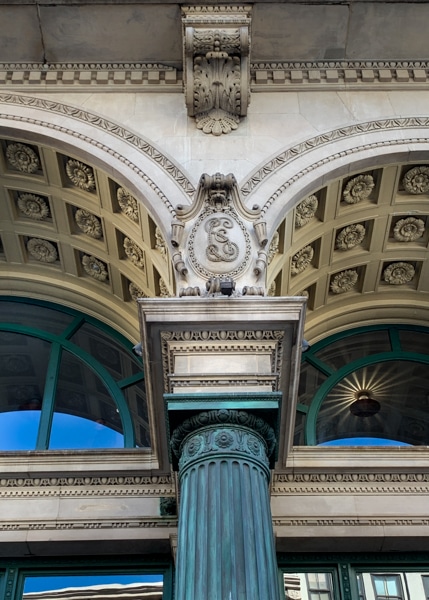
Besides the old Stern Brothers building, other highlights included the old Lord & Taylor at Broadway and 20th Streets, The O’Neill Building (originally Hugh O’Neill’s Dry Goods Store), and several other buildings along Sixth Avenue, for example, Siegel Cooper, which housed exclusive department stores around the turn of the 20th century and is now home to T.J. Maxx and Marshalls. Across the street, The Container Store was formerly the famous B. Altman & Company.
- Former Lord & Taylor building: 901 Broadway at E. 20th.
- O’Neill Building: 655 6th Ave.
- The Container Store: 629 6th Ave. (formerly B. Altman)
- T.J. Maxx:/ Marshalls 620 6th Ave. (formerly Siegel Cooper)
Washington Square Park
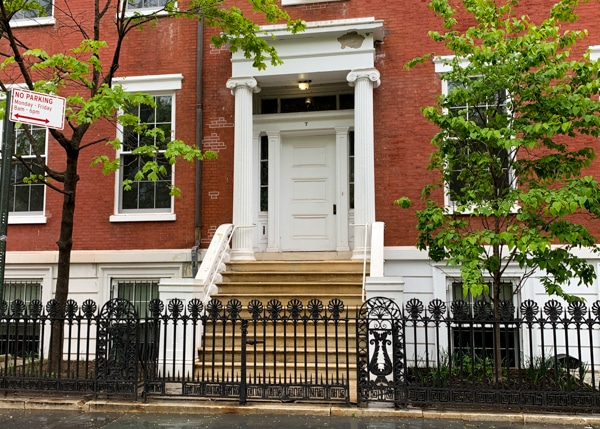
“If you want to follow the development of New York, just follow the money,” advised our guide, as we stood in front of a row of mansions on Washington Square North, all of them uniformly Greek Revival in style.
When Washington Square was officially declared a park in 1826, wealthy families immediately settled there, looking to escape the growing crowds of Lower Manhattan. Edith was among them at one point, having rented the house at 7 Washington Square North with her mother, shortly after her father died in Europe in 1882.
While she didn’t live there for long, she wrote a scene in The Age of Innocence that’s so short and yet so vivid in its description of the claustrophobic nature of her world.
While out on the rounds of after-dinner social calls, Newland Archer crosses Washington Square and walks up Fifth Avenue. While doing so, he notes which carriages are visiting which homes. He recognizes the figures, even in the gas-lit winter gloom, of the men entering and exiting homes on their own social calls.
A little further along, he spies Julius Beaufort, a shady English banker with a questionable background, climbing into his private carriage. Archer can only assume, since no other Society events are happening that evening, that “Beaufort’s outing was undoubtedly of a clandestine nature.”
Society, it seems, was always watching.

What would Edith make of Washington Square now? Her old house still exists, as does the park across the street, though I’m sure it’s a very different place today.
The central fountain is still there, shooting large plumes of water into the air, but I imagine what’s different is the glorious microcosm of the city that surrounds it: a live band playing professional quality jazz, a human statue coming to life after a dollar is dropped into his bucket, and a woman, precariously perched on top of a piano, belting out an opera. There is also Showtime, protest marches, picnics on the lawn, and on nice days, the spectacle of humans squeezing in every last moment of the day’s sunshine, like we do on every nice day in New York.
- Edith’s former home: 7 Washington Square North
- Subway: A, D, or F to W. 4th St. – Washington Square. N or Q to 8th St. 1 to Christopher St.
Grace Church
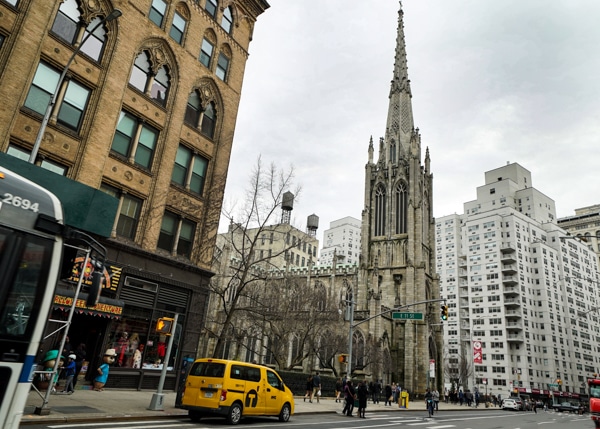
It seems to me that Edith Wharton’s Old New York exists most vividly at Grace Church, a Gothic Revival building built in 1846 and located in what is now the East Village. I could have spent hours at Grace Church. There is beauty everywhere you look, from nave to alter, floor to ceiling, and in each biblical scene embedded in the stained glass windows.
It was not difficult to imagine the scene of Archer and May’s wedding, which took place at Grace Church in The Age of Innocence. The church would have been packed with New York aristocracy, those wealthy families from old money who carried ancient Dutch or English blood lines.
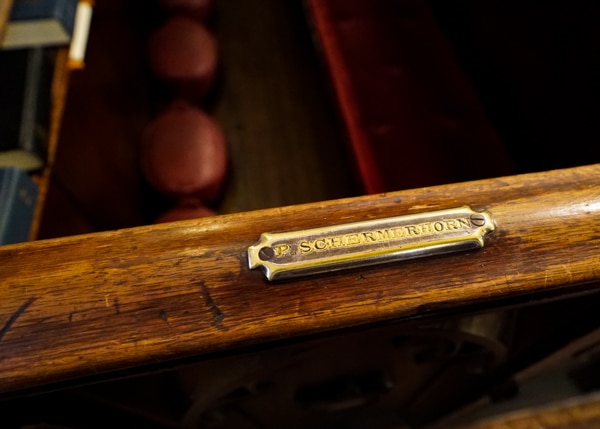
In fact, I was surrounded by signs of it. The pews are still marked with metal tags engraved with family names, many of them evoking Gilded Age royalty, the engravings now rubbed smooth with time. Edith herself was christened here, though her own wedding took place at what is now Saint Sava, the cathedral on West 25th Street that was gutted by a fire in 2016.
I thought of Archer as he waited with dread for his bride to appear, noting the absence of his true love Ellen Olenska. Bouquets of lilies decorated the altar while the scent of camphor drifted from the elderly ladies in the front pews.
I could easily picture it all, even though the only smell I noticed was that of faintly burning candles, and the only flowers in sight were two simple bouquets of white roses, placed on the high alter under a mosaic depiction of Christ arisen.
I imagined Archer during the ceremony, trained as he was in manners and etiquette, getting through it with little show of emotion. And then once it was over and he was alone with his new wife, fully understanding that his life had not changed, but instead “the same black abyss yawned before him.”
- Address: 802 Broadway, New York, NY
- Subway: N, Q, o R to 8th Street Station. 4, 5, or 6 to 14th St. – Union Square.
What would Edith think about New York today?
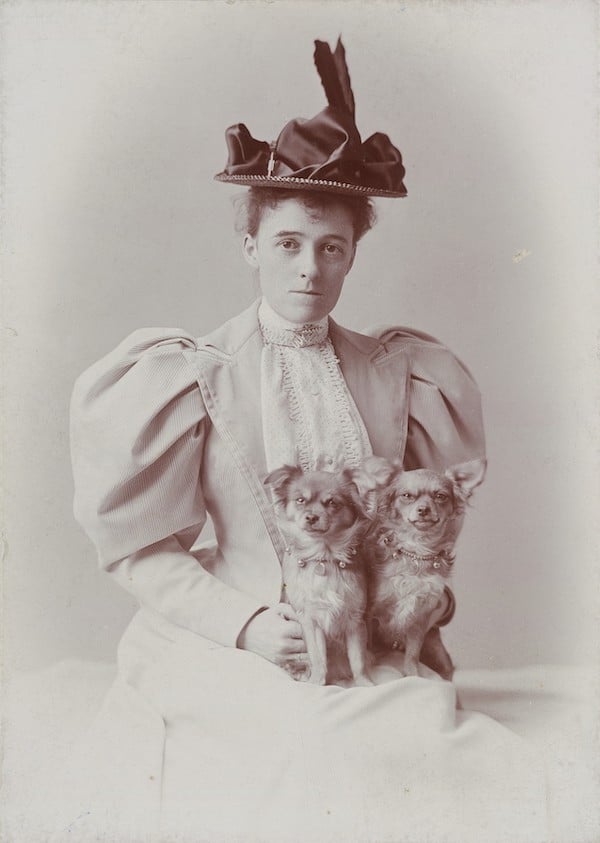
In the end, I did not find a lot of tangible evidence remaining of Edith Wharton’s New York. Her childhood home, besides the fact that it’s now an international coffee chain, has been remodeled so extensively that she likely wouldn’t recognize it.
Other buildings that make appearances in her novels no longer exist at all, such as the Academy of Music, where the opening scene of The Age of Innocence takes place. In the scene, New York Society, in all its Parisian fashion, is in attendance on opening night at the Opera, and it’s where Archer first meets Ellen Olenska. That building, formerly located at the corner of East 14th Street and Irving Place, was demolished long ago. The Consolidated Edison Building now sits in its place.
In fact, by the time Edith wrote The Age of Innocence in 1920, much of her world had marched relentlessly northward as the city grew larger and expanded.
I’m sure Edith wouldn’t find much order, beauty, or grace in today’s New York, at least not the kind she was seeking in her novels. Even then, she thought the city was ugly, describing the “shameless squalor” that formed her first impression upon returning by steamer to the docks of New York City after a childhood in Europe.
More than once in her writing, Edith has mentioned the ugliness of the city’s grid pattern and the “chocolate-colored coating” of brownstones, lamenting a city without the charm of European architecture. I doubt she would love the sparklingly modern Hudson Yards neighborhood and she’d most likely be appalled by today’s Times Square.
On the other hand, she might enjoy what, in my opinion, is one of New York City’s greatest gifts: you can attract attention to yourself all day long if you like and then, almost with a magic snap of your fingers, become anonymous, just like that.
Unlike in her day, when life was lived under intense scrutiny, today’s New York will leave you be. I think she would like that.
A Self-guided Tour of Edith Wharton’s Old New York
- Begin at Madison Square Park.
- Cross Fifth Ave. and go to Eataly.
- Cross W. 23rd St. to see Edith’s Childhood Home at Starbucks.
- Walk west a few steps to Home Depot to see an example of 19th century architecture.
- Walk southeast to the former Lord & Taylor building at Broadway and E. 20th St..
- Walk west to 6th Ave. to see the O’Neill Building.
- Walk south down 6th Ave. to see The Container Store, T.J. Maxx and Marshalls.
- Walk south on 6th Ave. to Washington Square Park and Edith’s former home there.
- Walk northeast to Grace Church.
